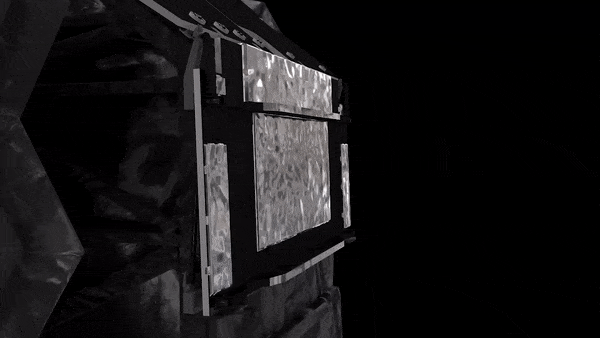James Webb Space Telescope deploys radiator to keep cool
A final latch unhooked to deploy the radiator into place, clearing the way for final mirror unfolding steps.

NASA's new high-tech, low-temp observatory observatory is one step closer to gathering some cool science.
The James Webb Space Telescope launched on Dec. 25 and has spent its time in space so far executing a complicated sequence of deployments to unfold the telescope to its final configuration. On Thursday (Jan. 6), the mission team notched another step of that sequence when at about 8:48 a.m. EST (1348 GMT), the telescope's Aft Deployable Instrument Radiator (ADIR) swung into place, according to a NASA statement.
The ADIR is a 4 foot (1.2 meters) by 8 foot (2.4 m) panel attached to the back of the observatory and connected by aluminum foil straps to Webb's instruments. The radiator is covered in honeycomb cells with an ultra-black surface, allowing the mechanism to pull heat away from the observatory instruments and send it into space, according to NASA.
Live updates: NASA's James Webb Space Telescope mission
Related: How the James Webb Space Telescope works in pictures
The ADIR was folded into launch configuration by four locks, three of which opened shortly after launch, according to NASA's timeline of JWST deployment steps. During the 15-minute process executed today, the final latch opened and the panel reached its final arrangement.
The radiator is a key piece of the technology that will allow the observatory to catch faint infrared signals. Because infrared light is connected to heat, infrared instruments must remain incredibly cold. Webb's radiator, combined with the observatory's massive sunshield and remote orbit on the opposite side of Earth from the sun, will keep heat away from the sensitive instruments.
Today's ADIR milestone comes the day after the observatory successfully deployed its secondary mirror, which is held on a tripod-like structure in front of the golden main mirror.
Breaking space news, the latest updates on rocket launches, skywatching events and more!
Next on the agenda is unfolding the two side panels of that primary mirror. JWST's primary mirror includes 18 individual segments, but the mirror in its final state would be too large to fit in the rocket fairing that launched the observatory. So two three-segment side panels launched while folded back.
The team will spend one day unfolding and latching each side panel, with the process expected to begin on Friday (Jan. 7) with the Port Primary Mirror Wing and concluding Saturday (Jan. 8) with the Starboard Primary Mirror Wing, although both processes can be rescheduled as the team sees fit.
NASA has said it will conduct a live broadcast from mission control of the second mirror wing deployment; the agency has also said it will hold a press conference after the process is complete.
Email Meghan Bartels at mbartels@space.com or follow her on Twitter @meghanbartels. Follow us on Twitter @Spacedotcom and on Facebook.
Join our Space Forums to keep talking space on the latest missions, night sky and more! And if you have a news tip, correction or comment, let us know at: community@space.com.

Meghan is a senior writer at Space.com and has more than five years' experience as a science journalist based in New York City. She joined Space.com in July 2018, with previous writing published in outlets including Newsweek and Audubon. Meghan earned an MA in science journalism from New York University and a BA in classics from Georgetown University, and in her free time she enjoys reading and visiting museums. Follow her on Twitter at @meghanbartels.
